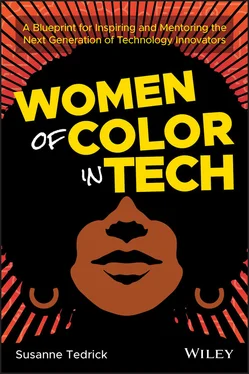201 199
202 200
203 201
204 202
205 203
206 204
207 205
208 206
209 207
210 209
211 210
212 211
213 212
214 213
215 214
216 215
217 216
218 217
219 218
220 219
221 220
222 221
223 222
224 223
225 224
226 225
227 226
228 227
229 228
230 229
231 230
232 231
233 233
234 234
235 235
236 236
237 237
238 238
239 239
240 240
241 241
242 243
243 244
244 245
245 246
246 247
247 248
248 249
249 250
250 251
251 252
252 253
253 254
254 255
255 256
256 257
257 258
258 259
259 iv
260 v
261 vii
262 ix
263 x
264 xi
265 260

Women of Color in Tech
A Blueprint for Inspiring and Mentoring the Next Generation of Technology Innovators
Susanne Tedrick

It all starts with a decision.
The willful choice to prioritize your interests in the face of the unknown, the uncharted, and what could be a long road of isolation.
It is met with an affirmation.
A belief that you belong here. That your ideas are worthwhile, your thoughts serve a purpose, and your perspective is a value add.
And accompanied by a notion.
A declaration that science, technology, engineering, and math don't have a color. They don't have a face. They belong to no one and everyone, for the whole and the betterment of all.
Your presence in STEM is an act of courage.
As if your choice to pursue your passions wasn't radical enough, here you are, prepared to beat the odds, defy the disparaging stats, and stare down adversity while carving a path, exploring new territory and laying our future.
Thank you for being a catalyst for innovation and the personification of endless possibility.
The work that you have done, and will do, is admirable, relevant, and necessary. You are just the right person to perform it.
Amanda Spann
Innovation Consultant & App Entrepreneur
AmandaSpann.com
One of the important duties in my job is helping customers figure out “why”: with all of the options that are available to them for their needs, and their limited time and resources, why is my product the one that they should choose?
Considering a career in tech prompts the same question. Of the career fields and options available, why should you, as a woman of color, pursue a career in technology? More specifically, why should you pursue this career field considering the well-known, heavily researched, and persistent challenges we continue to face in the field?
To be honest, I struggled with how to effectively answer that question every day while I wrote this book. I deal with many of the issues raised in this book, and more, such as the following:
Keeping up with dynamic and complex technology areas, while balancing what's demanded of me daily at work and home.
Dealing with the occasional insensitive comment made by the ignorant and the unpleasant, rooted in misconceptions about my race and gender, and then wrestling with whether to respond and be dubbed as “sensitive” or let the comment stand but let it slowly eat away at my spirit.
Seeing many people willing to give easy praise and “advice,” but few willing to publicly advocate on my behalf professionally. There are people who say they are allies but whose words, actions, and motivations reveal anything but.
Being the only one like me in the room and sometimes feeling tokenized.
For the women of color peers I do have, sadly watching them leave for other industries because they've simply had enough.
Feeling like I had to work 10 times harder to be taken seriously, let alone advance in my career, and feeling pressure to always exude perfection rather than vulnerability.
Some days, it was tough to get excited about what I do, and I kept thinking, if I can't excited about why I'm in tech and why I stay, then how can I inspire someone else to take this path ?
My “why”—what inspired me to come to tech and to stay—is that it is one of the few career fields that fully utilized my interests, skills, and passions. While I face challenges, and not always of the good, constructive kind, I am fully engaged. I love getting lost in my work, learning new things, and never having two days that are the same. I love what I do, and that love and the benefits I’ve received far outweigh any challenges that have come my way.
Tech is a field full of creativity, research, and discovery, where innovations can be used to solve the world's most pressing problems. Essential and purposeful work is being done all throughout the tech sector, and I love being part of the solution.
More importantly to me, I want to make the path easier for the future generations of female tech leaders. When they see other women of color out there and making it happen, despite the difficulties, then they know that there are not limited to opportunities that there have been historically. They know that these opportunities are out there, and they know that they truly are not alone, because we will always be there and have their backs.
It is not an easy path, but it can be a richly rewarding one—for your mind, your heart, and, hopefully, your wallet! I hope that you'll bring your talents and energies to the field, because you belong here, and you are very much needed.
Switching gears a bit … studying architecture is one of my favorite pastimes. What I love about architecture is that it can transform a building from being functional but ordinary into one that is memorable and iconic. It's what separates the Empire State Building or the Willis Tower from other tall office buildings. It can help a building become the standard that all other future buildings will measure themselves against.
Good architects require a strong understanding of what makes a building safe for people to enter and use on a regular basis and how to make it follow safety rules put in place by local agencies. Good architects also need to know how to take a client's requirements and translate them into a design that meets those basic needs and is pleasing to the mind and eyes. Considering that the average worker spends about a third of their life in an office, being in an office or building that is safe and pleasant is always ideal.
All great buildings start (and require) a blueprint before any major work is done. At a high level, a blueprint is a detailed technical drawing. Given the costs, resources, and time it takes to get a building from concept to reality, architects can't just approach the process haphazardly or without a solid plan. A blueprint details exactly what tasks or work needs to be done, what materials are to be used, and an estimate of the time and costs (tangible and intangible) that the project will take. Additionally, blueprints are constantly reviewed and revised, as needs (and challenges) arise.
To me, becoming a good tech professional is not much different. Tech professionals, at minimum, need to have solid technical skills. Depending on where you land in tech, this may mean knowing how and when to use various programming languages, knowing how to analyze massive amounts of data, or knowing how to keep computers and computer networks secure. In my job, I need to be able to effectively demonstrate complex technical concepts about cloud-native software development. If I'm unable to do that, I can end up losing credibility with clients and people within my organization.
Читать дальше














